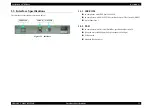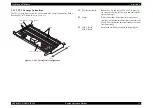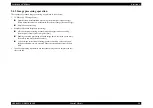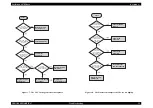
Perfection 4870 Photo
Revision A
OPERATING PRINCIPLES
Digital Ice function operation
24
2.2 Digital Ice function operation
This scanner has the Digital Ice function, which is divided into two types according to
the document type. Use the Print-Ice function for photos, and use the Film-Ice function
for positive films, color negative films and monochrome negative films.
2.2.1 Print-Ice function
Print-Ice function outline
This scanner has two visible light lamps for reflection. The lamps are placed
symmetrically to provide the same image when a scan is made twice. One of the
properties of a visible light is that it reflects irregularly when it radiates a flaw or
dust.
For this reason, the images obtained with the Lamps A and B have an inconsistent
portion if there is a flaw or dust. This function determines the inconsistent portion
as a flaw or dust and then automatically removes the flaw or the dust.
Print-Ice function sequence
1. Lights up the lamp A and scans the image.
2. Lights up the lamp B and scans the image.
3. Superimposes the images obtained from each lamp and determines the
inconsistent portion as a flaw or dust.
4. Erases the portion on the hardware, which has been detected in the step 3 and
obtains the image without any flaw and/or dust.
2.2.2 Film-Ice function
Film-Ice function outline
Longer in wavelength than a visible light, an infrared light has a property that it
scans a transparent document transparently. Hence, when a document with dust
and/or flaws are scanned using an infrared light, the infrared light is blocked at that
portion, providing an image that only the dust and/or the flaws are highly visible.
By superimposing the images scanned with an infrared light and a visible light, it
detects the dust and/or the flaws on the document and automatically removes them
using the interpolated and corrected image data near there.
However, since the wavelength differs between the infrared light and visible light,
the obtained images differ in size. To prevent this, the Carriage contains the
Solenoid-operated Glass Plate. When an image is scanned with a visible light, it is
read into the CCD via the Glass Plate to match it with the size of the image
obtained with an infrared light.
Figure 2-7. Refraction of Infrared Light and Visible Light
Lens
CCD
Glass Plate
Infrared light
Lens
CCD
Glass Plate
Infrared light
Summary of Contents for Perfection 4870 Photo
Page 1: ...EPSON Perfection4870Photo Color Image Scanner Service Manual SESC03 008 ...
Page 5: ...Revision Status Revision Date of Issue Description A December 10 2003 First release ...
Page 8: ...C H A P T E R 1 PRODUCTDESCRIPTION ...
Page 19: ...C H A P T E R 2 OPERATINGPRINCIPLES ...
Page 29: ...C H A P T E R 3 TROUBLESHOOTING ...
Page 37: ...C H A P T E R 4 DISASSEMBLY ASSEMBLY ...
Page 63: ...C H A P T E R 5 ADJUSTMENT ...
Page 65: ...C H A P T E R 6 MAINTENANCE ...
Page 68: ...C H A P T E R 7 APPENDIX ...
Page 71: ......
Page 72: ......
Page 73: ......
Page 74: ......
Page 75: ......
Page 76: ......
Page 77: ......
Page 78: ......
Page 79: ......
Page 80: ......
Page 81: ......
















































